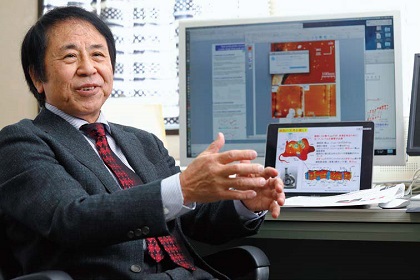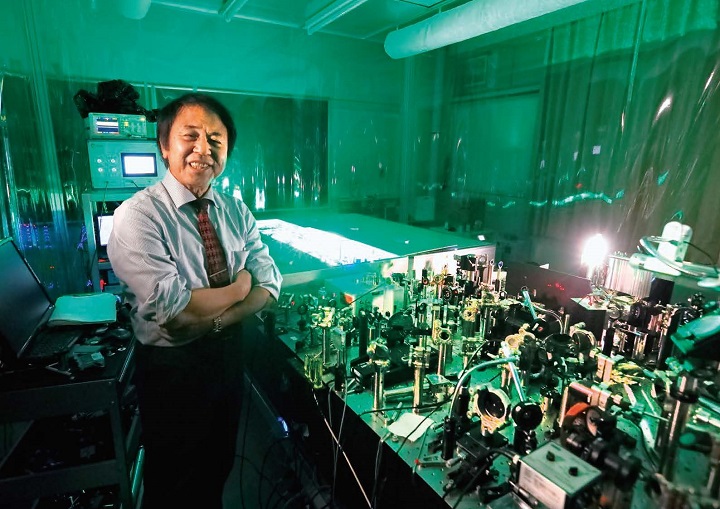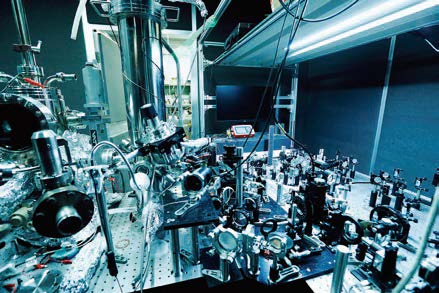TSUKUBA FRONTIER
#029 Sharpening Eyes to View the Nano-World: A Novel Microscope Reveals a World of Extremes
Professor SHIGEKAWA Hidemi, Faculty of Pure and Applied Sciences

A microscope is a device with which one can finely view states of matter. Depending on their type, microscopes are used not merely to enlarge, but to observe changing states of matter according to such criteria as temperature, light, and magnetic fields. Among these, an original microscope is being developed for the first time anywhere in the world that combines a physical phenomenon known as the "tunneling effect" with laser light, and will be used to elucidate previously hidden properties and functions of matter by capturing its atomic-level behavior over periods as short as one-quadrillionth of a second.
■ Smaller, Faster
A given substance may appear to be merely stationary, but the minute components constituting the substance, such as atoms and electrons, are carrying out various behaviors, and these movements result in the expression of the functions of the substance. Precisely capturing changes that occur instantaneously and at extremely high speeds can lead to the development of materials with novel functions. For example, although a semiconductor behaves according to principles described in textbooks, by gaining a more detailed understanding of the actual movements of atoms and electrons within the material, it becomes possible to endow the semiconductor with functions and performance that have never before been observed.
The scanning tunneling microscope (STM) is one tool used to observe matter in this way. By tracing the surface of a substance with a probe, the microscope enables one to "see" the surface shape with a precision finer than the size of a single atom. The STM was invented in the early 1980s, and has greatly contributed to the development of nanotechnology. On the other hand, in order to observe the ultra-rapid movements of molecules and atoms, laser spectroscopy methods are used. A substance is irradiated with laser light over the extremely short length of time of one femtosecond (one quadrillionth of a second), and the changes occurring in the substance at that time are detected. By combining these two technologies, both spatial resolution (size) and temporal resolution (speed) can aid in understanding the detailed behavior of the substance.
However, it took close to ten years to bring this idea to fruition. Various issues had to be dealt with, such as the thermal expansion of the STM probe due to the laser light irradiation causing fluctuations in the distance between probe and sample. By eliminating these problems one by one, the world's first "time-resolved STM," a new type of analytic apparatus, was completed.
■ Evolving Microscopes

Conventional microscopes are tools used to directly view matter. That is, their purpose was to learn in as much detail as possible about a substance--the way atoms and molecules are arranged, the crystal structure, and so on. However, today's microscopes have surpassed this. Various models have been developed to observe the response by matter when some stimulus is applied, whether light, temperature, a magnetic field, or something else. The substance is changed intentionally by the application of external stimuli, and from the nature of this change, latent properties of the substance are discovered.
Phenomena that we observe in various substances are the cumulative result of minute high-speed changes occurring within them, and the actions of the whole of these movements as a system. This is true whether the substance is an inorganic material such as a metal or a semiconductor, or the cells of a living organism. Time-resolved STM is a foundational technology that can be applied to an extremely broad range of subjects. Until now, we had only observed substances before and after they change; now, we are able to grasp even the dynamics of the process of change.
An analytic apparatus first proves its worth when there is a subject to be analyzed. For this reason, research on microscopes such as these is always conducted jointly with persons who specialize in the research field in which the microscope is being used. Discussions among people from different fields regarding what one wants to learn, and what measures are needed to learn it, result in further evolution of the apparatus, and simultaneously lead to new discoveries pertaining to the subject for analysis. In a virtuous circle, this new knowledge then opens the door to research on other themes.
■ From Nanotech to Living Organisms
It has already become possible to analyze semiconductors at the very fine level of several nanometers (where one nanometer is one one-billionth of a meter) using various methods. This has been accompanied by advances in performance, but in order to aim for further functional improvements, it is necessary to perceive things that could not be seen using the methods of the past. Even when it seems that we have learned all there is to know, through time-resolved STM observations it may be possible to uncover properties that until now have been hidden.
Of late, Prof. SHIGEKAWA has devoted much effort to the observation of cells in particular. The structure of cells is well known, but in fact different behavior is exhibited by different cells. For example, when a pharmaceutical is used for treatment of a disease or similar, there will be cells for which the drug is highly beneficial, and those for which it will not be. If it could be known what kinds of reactions were occurring in these cells, this information could be useful in the development of highly effective pharmaceuticals and delivery methods.
Observation of cells in the living state is important. However, they are extremely complicated entities with various molecules existing within them, and they cannot be observed under harsh conditions similar to those of other substances, involving the method of application of light, how a probe is used, the temperature, and so on. Efforts are underway to improve the apparatus so that individual molecules within cells can be observed in their appropriate states. Should it become possible to apply such methods in the field of biochemistry, a new approach for medical research would result.
■ Novel Experimental Techniques Advance Science
New analytical methods and techniques are always a major factor in the advance of science. As precision of measurement is improved and new principles are introduced, the formerly unknown becomes visible. There are numerous instances in which what had previously been mere conjecture or theory suggested by calculation results later came to be demonstrated as physical reality. Microscopes and other analytic instruments themselves do not tend to play a central role in research, but they have become indispensable in a number of research fields. In all fields, existing devices are improved, and programs and circuits are created in-house, according to what it is that researchers want to know.
Even so, a foundational and revolutionary analysis technology such as time-resolved STM cannot be easily created without experts in the field. At the time this new apparatus was announced, it was covered in the journal Nature and had a considerable impact, however few researchers around the world took up its cause. This is an indication of the degree of difficulty of this technology. In the last several years some competition has emerged, and further research is being conducted, with researchers aiming for yet another level by devising methods enabling application to any material.
■ Approaching the Secrets Held by All Matter
Prof. SHIGEKAWA began with the desire to understand matter at the atomic and molecular levels; this interest arose from a fundamental curiosity about the constitution of the universe. Therefore, he considered all materials, without any particular preferences regarding the object of the analysis. Microscopes are used to observe microscopic spaces, but it is thought that ultimately, by thoroughly investigating the microscopic, we may be able to elucidate the structure of the universe or the mysteries of life.
The universe and living organisms are, after all, constituted of atoms and elementary particles. The tunneling effect that is the principle employed in STMs played a part in the origin of the universe, according to some theories, and it seems that in some way they are connected. Research that utilizes both light and quantum chemistry to discover hidden properties of matter will no doubt someday lead to knowledge pertaining to the universe, and to life.

Time-Resolved Scanning Tunneling Microscopes (Time-Resolved STMs)
When the distance between the probe and the material approaches about 1 nm, and voltage is applied across this distance, current flows due to a quantum mechanical effect known as the tunneling phenomenon. When in this state the surface of the material is traced by moving the probe, and protrusions and depressions in the material surface can be detected. By combining this and a spectroscopic method in which the material is irradiated with laser light in pulses lasting about one quadrillionth of a second (a femtosecond), to detect changes occurring in extremely short lengths of time, a microscope was created that could simultaneously achieve both nanometer-level spatial resolution and femtosecond-level time resolution.

Article by Science Communicator at the Office of Public Relations


